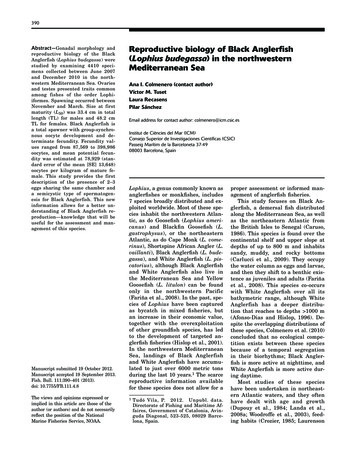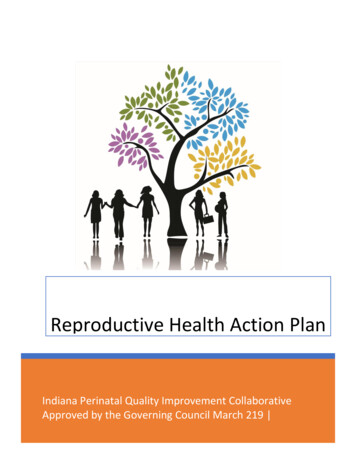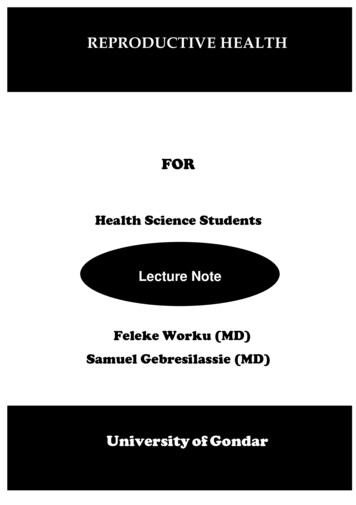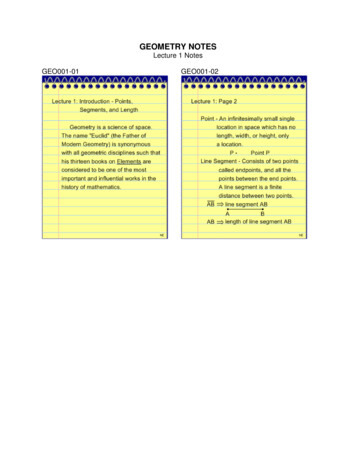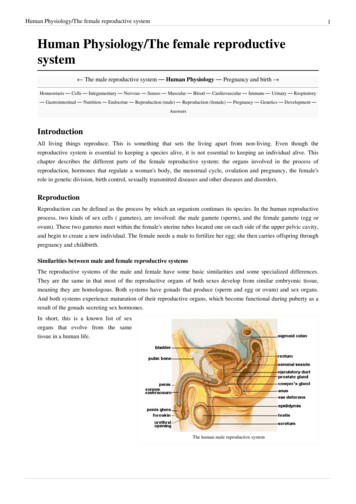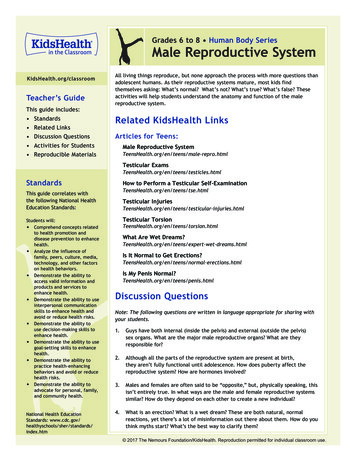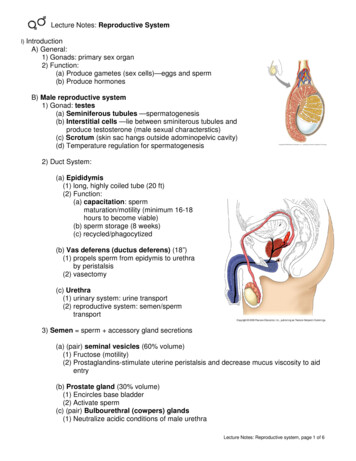
Transcription
Lecture Notes: Reproductive SystemI) IntroductionA) General:1) Gonads: primary sex organ2) Function:(a) Produce gametes (sex cells)—eggs and sperm(b) Produce hormonesB) Male reproductive system1) Gonad: testes(a) Seminiferous tubules —spermatogenesis(b) Interstitial cells —lie between sminiterous tubules andproduce testosterone (male sexual characterstics)(c) Scrotum (skin sac hangs outside adominopelvic cavity)(d) Temperature regulation for spermatogenesis2) Duct System:(a) Epididymis(1) long, highly coiled tube (20 ft)(2) Function:(a) capacitation: spermmaturation/motility (minimum 16-18hours to become viable)(b) sperm storage (8 weeks)(c) recycled/phagocytized(b) Vas deferens (ductus deferens) (18”)(1) propels sperm from epidymis to urethraby peristalsis(2) vasectomy(c) Urethra(1) urinary system: urine transport(2) reproductive system: semen/spermtransport3) Semen sperm accessory gland secretions(a) (pair) seminal vesicles (60% volume)(1) Fructose (motility)(2) Prostaglandins-stimulate uterine peristalsis and decrease mucus viscosity to aidentry(b) Prostate gland (30% volume)(1) Encircles base bladder(2) Activate sperm(c) (pair) Bulbourethral (cowpers) glands(1) Neutralize acidic conditions of male urethraLecture Notes: Reproductive system, page 1 of 6
4) Sperm (male gamete)(a) Head: (DNA) 23 Chromosomes(b) Acrosome: contains enzyme(hyaluronidase) which digests ovum’splasma membrane to allow for spermpenetration/ fertilization(c) Midpiece or middle piece: manymitochondria and small amounts of stored food(d) Flagella motility (3-4 inches per hour)C) Gametogenesis: Spermatogenesis1) Location: seminiferous tubules2) Spermatogonia (stem cell)(a) mitotic (clones)(b) primary spermatocyte (46 DNA)3) meiosis: type of cell division that produces gametes,cells with ½ number of chromosomes as parent cell(a) Meiosis I (IPMAT)(b) Meiosis II (PMAT)4) 64-72 daysLecture Notes: Reproductive system, page 2 of 6
D) Reproductive hormones of the male1) Gonadotropin-releasing hormone (GnRH):(a) Produced by hypothalamus(b) Function: Stimulate anterior pituitary to produce and release FSH and LH2) FSH (Follicle Stimulating Hormone)(a) produced by anterior pituitary gland(b) Function: stimulate spermatogenesis3) LH (Leutenizing hormone)(a) produced by anterior pituitary gland(b) Function: stimulate interstitial cells toproduce testosterone4) Testosterone: main male sex hormone(a) Development and functioning of the sex organs(b) regulate the testosterone levels in theblood(c) Development/maintenance of secondarysexual characteristics (features ofnonreproductive system organs!)(1) Greater height than (2) Greater muscle mass(3) Broad shoulders(4) Longer legs relative to trunk length(5) Deeper voices/ More pronounced Adam’s apple (part of the larynx)(6) Distribution of body hair/ Receding hair lineE) Female reproductive system1) General:(a) Gonad: Ovary (paired) held in position by ligaments(b) site of gametogenesis/oogenesis(c) born with 2(106) partially formed, decreases to 400,000 bypuberty and only 400 mature(d) Produce hormones (estrogen/progesterone)(e) Protect/nurture developing fetusLecture Notes: Reproductive system, page 3 of 6
2) Gametogenesis: Oogenesis/Ovarian Cycle3) Uterine tubes or Fallopian Tubes(a) 4” long funnel with fimbriae (finger-like projections catch oocyte(b) lined with ciliated epithelial cells(c) smooth muscle (peristalsis)4) Uterus(a) size/shape pear(b) myometrium (muscle)—rhythmic contractions(c) endometrium: mucosal lining undergoes cyclic changes (shed during menses)(d) site of embryo implantation and development5) cervix: narrowed neck6) vaginaLecture Notes: Reproductive system, page 4 of 6
F) Reproductive hormones of the female1) Gonadotropin-releasing hormone (GnRH):(a) Produced by hypothalamus(b) Function: stimulates anterior pituitary gland to produce FSH and LH2) FSH (Follicle Stimulating Hormone)(a) Produced by anterior pituitarygland(b) gametogenesis3) LH (leutenizing hormone)(a) Produced by anterior pituitarygland(b) Stimulates follicular cells toproduce female hormones(c) Triggers maturation andovulation4) Estrogen (ovary—developingfollicles/follicular cells)(a) Stimulate growth, maturationand maintenance of femalereproductive organs(b) promote proliferative phase ofuterine cycle-prepares uterusfor implantation5) Progesterone (ovary—follicular cells/corpus luteum)(a) promotes uterine secretory phase(b) maintains uterus during pregnancy(c) causes mammary glands to mature and produce milk during pregnancyG) Uterine cycle: Average cycle lasts 28 days.1) Days 1-5 Menstrual phase(a) Uterus/ endometrium is shed2) Days 6-13 Proliferative phase(a) Estrogen prepares uterus(b) Increase blood supply/glandular epithelium3) Day 14 (LH Peaks) ovulation4) Days 15-28 Secretory phase(a) endometrium prepares for implantation (low FSH and LH)(b) progesterone promotes vascular growth and glands secrete nutrients to sustainembryo(c) no fert corpus luteum stops progesterone and FSH/LH rise and repeatsLecture Notes: Reproductive system, page 5 of 6
H) Fertilization and pregnancy:1) Fertilization occurs within 24 hrs of ovulation within the upper (fallopian) uterine tube2) The dividing mass of cells travels down the fallopian tube3) Embryo implants in the endometrium4) from fertilization to implantation—about 14 days5) NOTE: 60% of all fertilized eggs fail to implant6) The placenta develops from fetal and maternal tissue(a) Human chorionic gonadotropin (HCG): maintains the corpus luteum until chorioncan produce enough progesterone to inhibit maturation and ovulation of anotheroocyteLecture Notes: Reproductive system, page 6 of 6
Lecture Notes: Reproductive system, page 5 of 6 F) Reproductive hormones of the female 1) Gonadotropin-releasing hormone (GnRH): (a) Produced by hypothalamus (b) Function: stimulates anterior pituitary gland to produce FSH and LH



